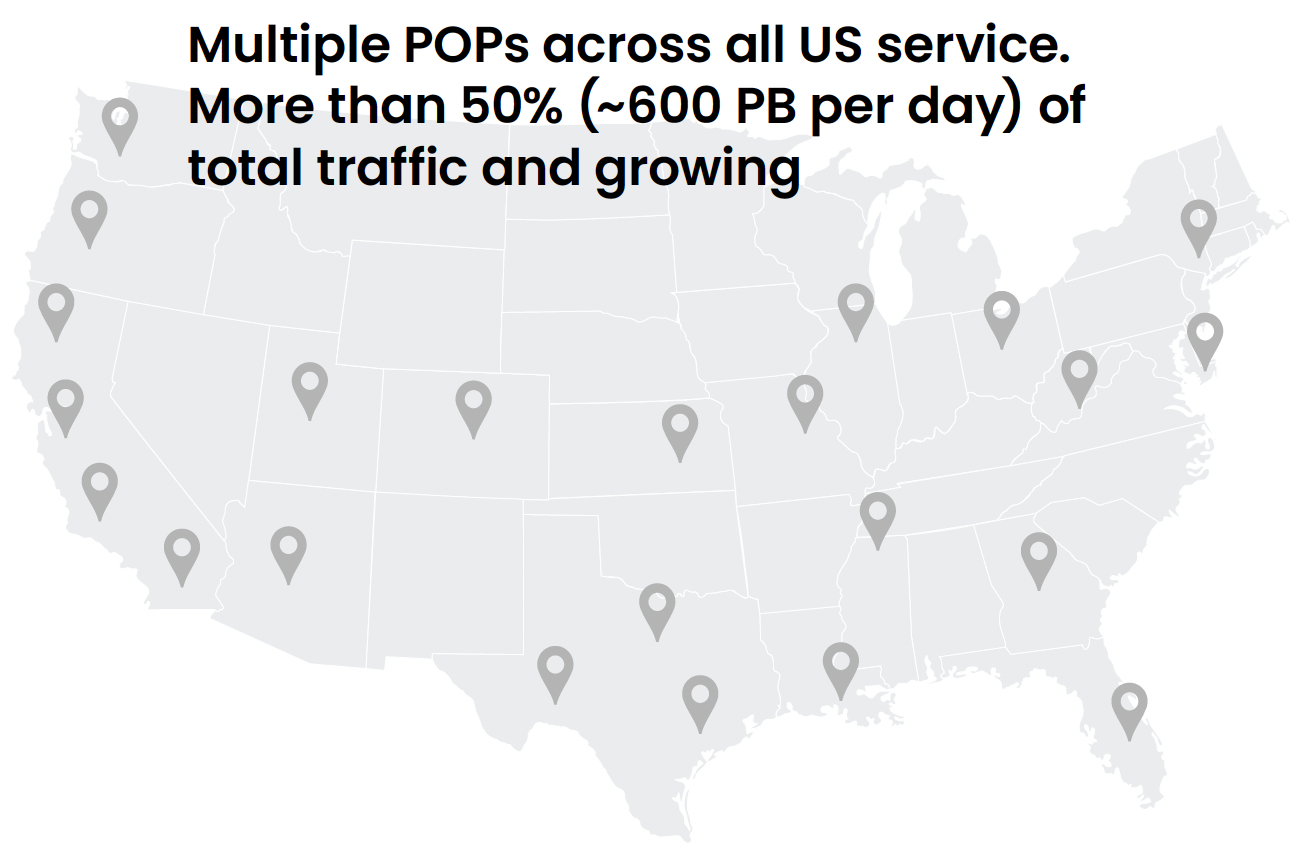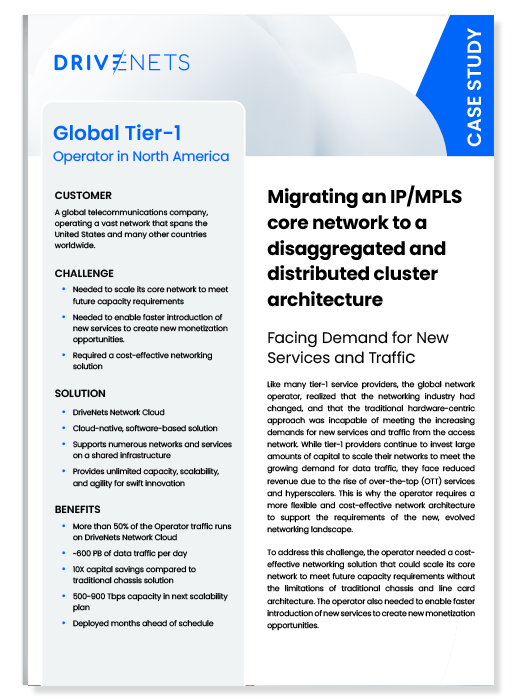Case StudiesApril 9, 2024
Migrating an IP/MPLS core network to a disaggregated and distributed cluster architecture
Key requirements
- Convergence: Provide efficient transport and handling of diverse traffic on a unified network infrastructure.
- Carrier Grade: Provide a high-performing, reliable, and scalable networking solution that meets the operator’s strict requirements.
- Scalability: Meet any evolving customer needs and enable business efficiency.
- Cloud-like: Provide a cloud-like flexibility, cost-effectiveness, and operational efficiency.
- Openness: Enable third-party participation, increased visibility and expanded partnerships.
SOLUTION: Build Networks Like Cloud
The DriveNets Network Cloud solution is designed to meet the needs of tier-1 service providers in the rapidly evolving networking landscape of emerging technologies and business needs. This cloud-native, software-based solution supports numerous networks and services on a shared infrastructure with unlimited capacity, scalability, and agility for swift innovation.
In this project, traditional hardware-based core routers are disaggregated into building blocks. The control plane runs on x86 servers, while the data plane is implemented as a cluster of multiple white boxes interconnected as one router using a Clos topology. The operator uses white boxes from UfiSpace powered by Broadcom’s NPU ASICs. The cluster is based on only two types of white boxes: the Network Cloud Packet Forwarder (NCP) and the Network Cloud Fabric (NCF).
The DriveNets Network Operating System (DNOS) runs as a service instance (SI) microservice in a cloud container, utilizing any underlying hardware resource, including physical interfaces, NPUs, CPUs, TCAMs, etc. This setup can scale up to an impressive capacity of 819Tbps, made up of dozens of white boxes operating as a single routing entity, and can be operated using one command-line interface (CLI).
RESULTS
DriveNets Network Cloud has been successfully deployed as the operator’s next-generation, open, disaggregated core routing platform. The deployment began in 2020 and has since expanded to more geographies within the service provider’s production core networks at an accelerated pace. DriveNets Network Cloud enabled them to be more efficient in rolling out new services such as 5G and fiber to the x (FTTX), while also providing more advanced services in existing markets.

DriveNets Network Cloud fulfilled the operator’s key requirements
- Scalability: The system began with the world’s first single router capacity of 192 Tbps, which now supports ~600 petabytes of global data traffic per day. There are plans to scale the system to 500 Tbps and eventually to 900 Tbps using next-generation chipsets.
- Openness: The Distributed Disaggregated Chassis (DDC) solution is based on Open Compute Project (OCP) guidelines. This allows the operator to achieve flexibility and vendor diversity across all hardware elements, leading to reduced costs. The service provider can now mix and match any suitable components from a wide range of available ASICs, hardware, software, and optics vendors.
- Carrier grade: By the end of 2022, DriveNets software was responsible for driving over 50% of all production traffic to the operator’s next-gen core routers, while meeting all performance, reliability, and service availability metrics.
- Cloud-like operations: Streamlined network planning, reduced SKU complexity, and smoother warehouse logistics. Additionally, its distributed structure and inherent redundancy enhanced network reliability and simplified maintenance by enabling the replacement of individual whiteboards instead of whole systems.
- Convergence: Supports various use cases using the same two white boxes across different network domains. The solution also supports cost savings by collapsing Layer-1 to Layer-3 communications into a single platform using ZR/ZR+ optical modules.
“We enjoy this relationship. We enjoy the disruption. We enjoy the ability to work together and push some boundaries in our ability to deliver not just software, but actually a full service. We can deploy.”
Senior Network Executive, Global Tier-1 Operator in North America
SUMMARY
Looking back, the operator was one of the early service providers to recognize the changing landscape of the
networking world and the need for a new network architecture to support increasing data traffic. The operator
did not just wait for the technology to appear; it took an active role in solution design and made a significant
contribution to the concept of DDC in the OCP Telco Project.
DriveNets Network Cloud incorporated the DDC guidelines and successfully fulfilled the operator’s key
requirements, while also expanding the system’s implementation into a managed resource pool, similar to cloud
computing. As a result, the operator can build its core network like cloud, which mean a more agile and cost effective network architecture.







